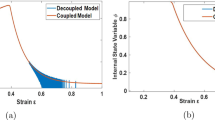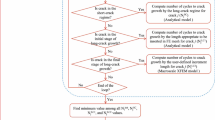Abstract
In the scope of this work, a micromechanical model based on the crystal plasticity finite element method is proposed and applied to describe the nucleation and growth of microstructurally short fatigue cracks in polycrystalline materials under cyclic loads. The microstructure is generated in the form of a representative volume element of a polycrystalline material with equiaxed grains having columnar structure along thickness and random crystallographic texture. With this model, we investigate the influence of loading amplitude on the crack growth behavior. It is shown that for smaller strain amplitudes, a single crack nucleates and propagates, while for larger strain amplitudes several independent crack nucleation sites form, from which microcracks start propagating. It is also observed that the global plastic strain amplitude decreases from the initial to the final cycle, during total strain-controlled loading. However, this can even increase the crack growth rate because the crack advance is governed by the local plastic slip which accumulates at the crack tip over the number of cycles. With this work, it is shown that micromechanical modeling can strongly improve our understanding of the mechanisms of short-crack nucleation and growth under fatigue loading.








Similar content being viewed by others
References
H.J. Christ, C.P. Fritzen, and P. Köster: Micromechanical modeling of short fatigue cracks. Curr. Opin. Solid State Mater. Sci. 18, 205 (2014).
H. Mughrabi: Microstructural fatigue mechanisms: Cyclic slip irreversibility, crack initiation, non-linear elastic damage analysis. Int. J. Fatigue 57, 2 (2013).
O. Aslan, S. Quilici, and S. Forest: Numerical modeling of fatigue crack growth in single crystals based on microdamage theory. Int. J. Damage Mech. 20, 681 (2011).
H. Mughrabi: On the life-controlling microstructural fatigue mechanisms in ductile metals and alloys in the gigacycle regime. Fatigue Fract. Eng. Mater. Struct. 22, 633 (1999).
H. Mughrabi: On “multi-stage” fatigue life diagrams and the relevant life-controlling mechanisms in ultrahigh-cycle fatigue. Fatigue Fract. Eng. Mater. Struct. 25, 755 (2002).
K. Tokaji and T. Ogawa: The growth behaviour of microstructurally small fatigue cracks in metals. Mech. Eng. Publ. 13, 85 (1992).
S. Suresh: Fatigue of Materials (Cambridge University Press, Cambridge, U.K., 1998).
V. Bennett and D.L. McDowell: Mixed-Mode Crack Behavior (ASTM International, West Conshohocken, Pennsylvania, 1999); pp. 203–228.
I. Simonovski, K.F. Nilsson, and L. Cizelj: The influence of crystallographic orientation on crack tip displacements of microstructurally small, kinked crack crossing the grain boundary. Comput. Mater. Sci. 39, 817 (2007).
U. Krupp, O. Düber, H.J. Christ, B. Künkler, A. Schick, and C.P. Fritzen: Application of the EBSD technique to describe the initiation and growth behaviour of microstructurally short fatigue cracks in a duplex steel. J. Microsc. 213, 313 (2004).
C.P. Przybyla and D.L. McDowell: Microstructure-sensitive extreme value probabilities for high cycle fatigue of Ni-base superalloy IN100. Int. J. Plast. 26, 372 (2010).
D.L. McDowell and F.P.E. Dunne: Microstructure-sensitive computational modeling of fatigue crack formation. Int. J. Fatigue 32, 1521 (2010).
Y. Li, V. Aubin, C. Rey, and P. Bompard: Microstructural modeling of fatigue crack initiation in austenitic steel 304L. Procedia Eng. 31, 541 (2012).
N. Marchal, S. Forest, L. Rémy, and S. Duvinage: Fatigue and creep. Local Approach to Fracture EUROMECH-MECAMAT 2006, 9th European Mechanics of Materials Conference, D.S.J. Besson and D. Moinereau, ed. (Presses des Mines de Paris, Moret Sur Loing, France, 2006); pp. 353–358.
L.G. Zhao, N.P. O’Dowd, and E.P. Busso: A coupled kinetic-constitutive approach to the study of high temperature crack initiation in single crystal nickel-base superalloys. J. Mech. Phys. Solids 54, 288 (2006).
L.G. Zhao, J. Tong, and J. Byrne: The evolution of the stress–strain fields near a fatigue crack tip and plasticity-induced crack closure revisited. Fatigue Fract. Eng. Mater. Struct. 27, 19 (2004).
J. Tong, B. Lin, Y.W. Lu, K. Madi, Y.H. Tai, J.R. Yates, and V. Doquet: Near-tip strain evolution under cyclic loading: In situ experimental observation and numerical modelling. Int. J. Fatigue 71, 45 (2015).
J.D. Carroll, W. Abuzaid, J. Lambros, and H. Sehitoglu: High resolution digital image correlation measurements of strain accumulation in fatigue crack growth. Int. J. Fatigue 57, 140 (2013).
K.J. Miller: The short crack problem. Fatigue Fract. Eng. Mater. Struct. 5, 223 (1982).
K. Tokaji, T. Ogawa, Y. Harada, and Z. Ando: Limitations of linear elastic fracture mechanics in respect of small fatigue cracks and microstructure. Fatigue Fract. Eng. Mater. Struct. 9, 1 (1986).
J.R. Rice: Tensile crack tip fields in elastic-ideally plastic crystals. Mech. Mater. 6, 317 (1987).
K. Gall, H. Sehitoglu, and Y. Kadioglu: FEM study of fatigue crack closure under double slip. Acta Mater. 44, 3955 (1996).
G.R. Leverant and M. Gell: The influence of temperature and cyclic frequency on the fatigue fracture of cube oriented nickel-base superalloy single crystals. Metall. Trans. A 6, 367 (1975).
J.S. Crompton and J.W. Martin: Crack tip plasticity and crack growth in a single-crystal superalloy at elevated temperatures. Mater. Sci. Eng. 64, 37 (1984).
P.B. Aswath: Effect of orientation on crystallographic cracking in notched nickel-base superalloy single crystal subjected to far-field cyclic compression. Metall. Mater. Trans. A 25, 287 (1994).
A.L. Gurson: Continuum theory of ductile rupture by void nucleation and growth: Part I—Yield criteria and flow rules for porous ductile media. J. Eng. Mater. Technol. 99, 2 (1977).
V. Tvergaard and A. Needleman: Analysis of the cup-cone fracture in a round tensile bar. Acta Metall. 32, 157 (1984).
R. Mahnken: Theoretical, numerical and identification aspects of a new model class for ductile damage. Int. J. Plast. 18, 801 (2002).
R. Lillbacka, E. Johnson, and M. Ekh: A model for short crack propagation in polycrystalline materials. Eng. Fract. Mech. 73, 223 (2006).
B. Künkler, C-P. Fritzen, O. Düber, U. Krupp, and H-J. Christ: Simulation of short crack propagation—Transition from stage I to stage II. Proc. Appl. Math. Mech. 5, 341 (2005).
O. Düber, B. Künkler, U. Krupp, H.J. Christ, and C.P. Fritzen: Experimental characterization and two-dimensional simulation of short-crack propagation in an austenitic-ferritic duplex steel. Int. J. Fatigue 28, 983 (2006).
G.M. Castelluccio: A Study on the Influence of Microstructure on Small Fatigue Cracks (Georigia Institute of Technology, 2012).
J.L. Bouvard, J.L. Chaboche, F. Feyel, and F. Gallerneau: A cohesive zone model for fatigue and creep–fatigue crack growth in single crystal superalloys. Int. J. Fatigue 31, 868 (2009).
M. Boeff: Micromechanical modelling of fatigue crack initiation and growth. Ph.D. thesis, Ruhr Universität Bochum, Germany, 2016.
M. Boeff, H.U. Hassan, and A. Hartmaier: Micromechanical modeling of fatigue crack initiation in polycrystals. J. Mater. Res. 32, 4375 (2017).
Cubit 13.2 by (Sandia National Laboratories, Albuquerque, New Mexico, 2013).
J.R. Rice: Inelastic constitutive relations for solids: Theory and its application to metal plasticity. J. Mech. Phys. Solids 19, 433 (1971).
J.W. Hutchinson: Bounds and self-consistent estimates for creep of polycrystalline materials. Proc. R. Soc. A 348, 101 (1976).
F. Roters, P. Eisenlohr, L. Hantcherli, D.D. Tjahjanto, T.R. Bieler, and D. Raabe: Overview of constitutive laws, kinematics, homogenization and multiscale methods in crystal plasticity finite-element modeling: Theory, experiments, applications. Acta Mater. 58, 1152 (2010).
K. Inal, J.L. Lebrun, and M. Belassel: Second-order stresses and strains in heterogeneous steels: Self-consistent modeling and X-ray diffraction analysis. Metall. Mater. Trans. A 35, 2361 (2004).
S. Mahmoody: Micromechanical Modeling of Dual-Phase Steel Using a Rate-Dependent Crystal Plasticity Model (McGill University, Montreal, Canada, 2003).
D.L. McDowell: Simulation-based strategies for microstructure-sensitive fatigue modeling. Mater. Sci. Eng., A 468–470 (Spec. Iss.), 4 (2007).
A. Manonukul and F.P.E. Dunne: High- and low-cycle fatigue crack initiation using polycrystal plasticity. Proc. R. Soc. London, Ser. A 460, 1881 (2004).
G. Pijaudier-Cabot and Z. Bazant: Nonlocal damage theory. J. Eng. Mech. 113, 1512–1533 (1987).
R.H.J. Peerlings: Enhanced Damage Modelling for Fracture and Fatigue (Technische Universiteit Eindhoven, Eindhoven, Netherlands, 1999).
J. Polák, T. Kruml, K. Obrtlík, J. Man, and M. Petrenec: Short crack growth in polycrystalline materials. Procedia Eng. 2, 883 (2010).
M. Schlesinger: Experimentelle Untersuchung Des Zeitabhängigen Rissfortschritts Unter Thermomechanischer Ermüdung in Nickellegierungen Und Mechanismenbasierte Modelle Zur Lebensdauerbewertung (Shaker Verlag, Aachen, 2014).
Acknowledgments
The authors thank Michael Schlesinger from the Fraunhofer Institute for mechanics of materials (IWM) Freiburg for providing the experimental results for the qualitative comparison of our numerical model.
Author information
Authors and Affiliations
Corresponding author
Rights and permissions
About this article
Cite this article
Boeff, M., Hassan, H.u. & Hartmaier, A. On the numerical modeling of nucleation and growth of microstructurally short cracks in polycrystals under cyclic loading. Journal of Materials Research 34, 3523–3534 (2019). https://doi.org/10.1557/jmr.2019.270
Received:
Accepted:
Published:
Issue Date:
DOI: https://doi.org/10.1557/jmr.2019.270




